Actionset
Overview
The thigh muscles (quadriceps) help keep the kneecap (patella) stable and in place. Weak quadriceps increase the risk of patellar tracking disorder.
Ligaments and tendons also help stabilize the patella. If these are too tight or too loose, you have a greater risk of patellar tracking disorder.
The goals of non-surgical treatment of patellar tracking problems are to reduce symptoms, increase quadriceps strength and endurance, and return to normal function. Exercises for patellar tracking disorder are not complicated and can be done at home in about 20 minutes a day.
- Most patellar tracking problems can be treated effectively without surgery. Non-surgical treatment may include rest, regular stretching and strengthening exercises, taping or bracing the knee, using ice, and short-term use of non-steroidal anti-inflammatory drugs (NSAIDs).
- Quadriceps strengthening is the most commonly prescribed treatment for patellar tracking disorder. Exercises to increase flexibility and to strengthen the muscles around the hip can also help.
- Patience and dedication are essential. The slow progress and improvement can be frustrating. But most people can be spared a surgical procedure by closely following a conservative therapy program.
Be sure to stay on your exercise program. You may not notice much improvement in your symptoms right away, and recovery can take several months. Problems can come back if you don't keep your strength and flexibility.
How do you do exercises for patellar tracking disorder?
Correct diagnosis is of great importance in designing an exercise or rehabilitation program. The treatment you receive and the exercise program you use to rehabilitate your knee should be developed specifically for your condition. Some doctors will recommend using a brace or a taping technique to keep your kneecap in proper alignment, in addition to an exercise program. Be sure to closely follow the instructions from your doctor or physiotherapist.
At first, following an injury or a flare-up of symptoms of patellar tracking disorder, knee activity should be reduced. Overuse and trauma are common causes of knee pain. And resting your knee will help relieve pain. Exercises should begin as the symptoms resolve.
Your doctor or physiotherapist should help you decide what exercises to do. He or she will probably have you start with one or two exercises and add others over time. Your physiotherapist may use biofeedback during some exercises to help you learn to contract certain muscles, especially the inner muscle of your quadriceps.
Quad sets and mini squats may be the first exercises that your doctor or physiotherapist recommends.
Quad sets
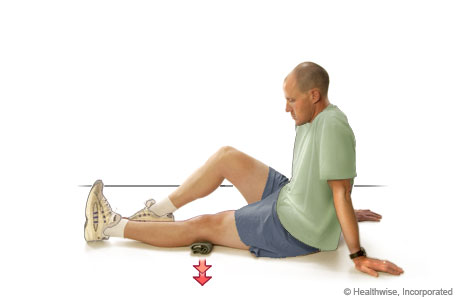
- Sit with your leg straight and supported on the floor or a firm bed. (If you feel discomfort in the front or back of your knee, place a small towel roll under your knee.)
- Tighten the muscles on top of your thigh by pressing the back of your knee flat down to the floor. (If you feel discomfort under your kneecap, place a small towel roll under your knee.)
- Hold for about 6 seconds, then rest up to 10 seconds.
- Do this for 8 to 12 repetitions several times a day.
Mini squat
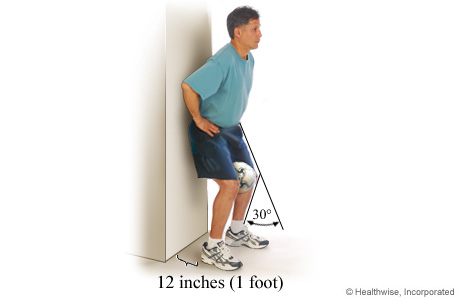
- Stand with your feet about hip-width apart and 12 inches from a wall.
- Lean against the wall and slide down until your knees are bent about 20 to 30 degrees.
- Place a ball about the size of a soccer ball between your knees and squeeze your knees against the ball for about 6 seconds at a time.
- Rest a few seconds, then squeeze again.
- Repeat 8 to 12 times, at least 3 times a day.
When your doctor or physical therapist thinks your knee is ready, he or she may recommend more intensive exercise.
Straight-leg raises to the front
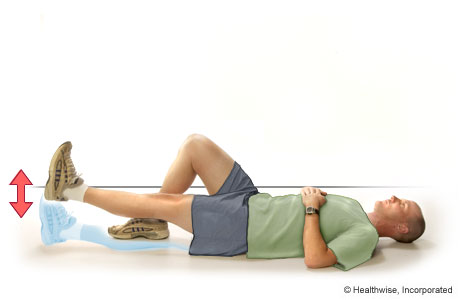
Note: For straight-leg raise exercises, your physiotherapist may have you add light ankle weights as you become stronger.
- Lie on your back with your good knee bent so that your foot rests flat on the floor. Your injured leg should be straight. Make sure that your low back has a normal curve. You should be able to slip your flat hand in between the floor and the small of your back, with your palm touching the floor and your back touching the back of your hand.
- Tighten the thigh muscles in the injured leg by pressing the back of your knee flat down to the floor. Hold your knee straight.
- Tighten the quadriceps muscles of your straight leg and lift the leg 30 to 45 cm (12 to 18 in.) off the floor. Hold for about 6 seconds, then slowly lower the leg back down and rest a few seconds.
- Do 8 to 12 repetitions, 3 times a day.
Straight-leg raises to the inside
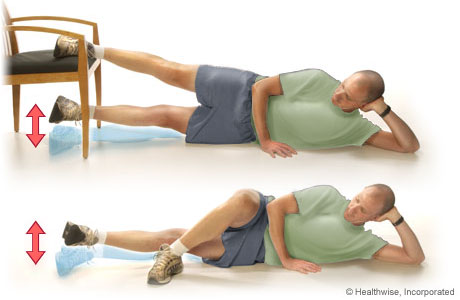
- Lie on your side with the leg you are going to exercise on the bottom and your other foot either up on a chair or flat on the floor in front of your knee.
- Tighten your thigh muscles, and then lift your leg straight up away from the floor.
- Hold for about 6 seconds, slowly lower the leg back down, and rest a few seconds.
- Do 8 to 12 repetitions, 3 times a day.
Straight-leg raises to the outside
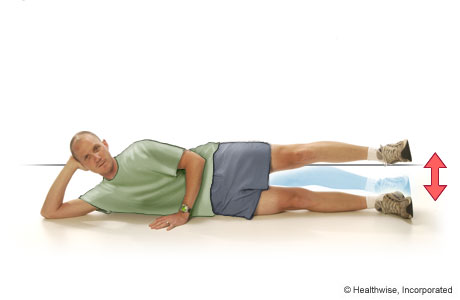
- Lie on your side with the leg you are going to exercise on top.
- Tighten your thigh muscles, and then lift your leg straight up away from the floor.
- Keep your hip and your leg straight in line with the rest of your body, and keep your knee pointing forward. Do not drop your hip back.
- Hold for about 6 seconds, slowly lower the leg back down, and rest a few seconds.
- Do 8 to 12 repetitions, 3 times a day.
Straight-leg raises to the back
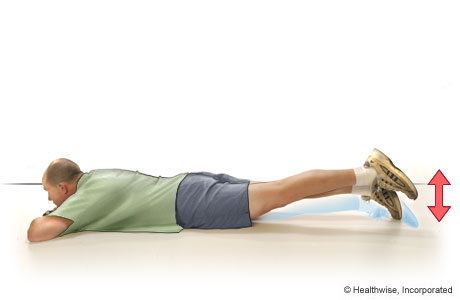
- Lie on your belly.
- Tighten your thigh muscles, and then lift your leg straight up away from the floor.
- Hold for about 6 seconds, slowly lower the leg back down, and rest a few seconds.
- Do 8 to 12 repetitions, 3 times a day.
Shallow standing knee bends
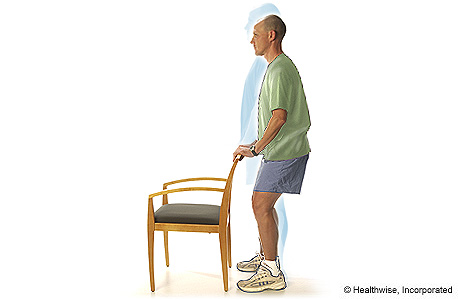
- Stand with your hands lightly resting on a counter or chair in front of you. Place your feet shoulder-width apart.
- Slowly bend your knees so that you squat down like you are going to sit in a chair. Make sure your knees do not go in front of your toes.
- Lower yourself about 15 cm (6 in.). Your heels should remain on the floor at all times.
- Rise slowly to a standing position.
- Do 8 to 12 repetitions, 3 times a day.
Remember to limit the bend of your knee to a 30-degree angle at first. When your knee is bent past this point, your kneecap will have more contact with the thigh bone, causing more pressure, pain, and possible cartilage damage.
Shallow knee bend on one leg
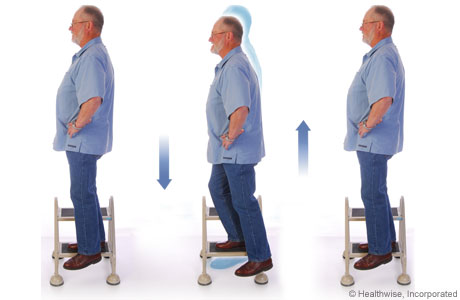
- Stand on a step, on the leg you want to exercise. Let your other leg hang down off the step.
- Keeping your head up and your back straight, lean slightly forward. Hold on to a banister if you feel unsteady.
- Slowly bend your knee so the foot hanging down moves down toward the floor, then slowly straighten your knee again. Your heel should stay on the step, and your knee should not go any farther forward than your toe. As you bend and straighten your leg, try to keep your knee moving in a straight line with your middle toe.
- Do 8 to 12 repetitions.
Remember to limit the bend of your knee to a 30-degree angle at first. When your knee is bent past this point, your kneecap will have more contact with the thigh bone, causing more pressure, pain, and possible cartilage damage.
Standing quadriceps stretch
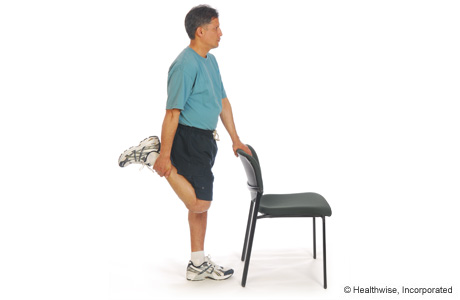
- If you are steady on your feet, stand holding a chair, counter, or wall. You can also lie on your stomach or your side to do this exercise.
- Bend the knee of the leg you want to stretch, and grab the front of your foot with the hand on the same side. For example, if you are stretching your right leg, use your right hand.
- Keeping your knees next to each other, pull your foot toward your buttock until you feel a gentle stretch across the front of your hip and down the front of your thigh. Your knee should be pointed directly to the ground, and not out to the side.
- Hold the stretch for at least 15 to 30 seconds. Repeat 2 to 4 times.
Hamstring stretch in doorway
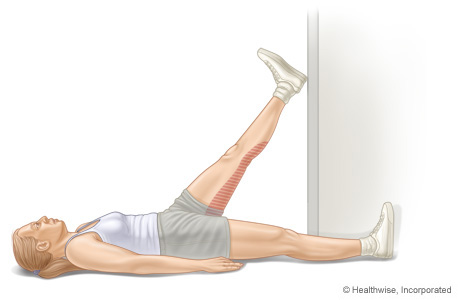
- Lie on the floor near a doorway, with your buttocks close to the wall.
- Let the leg you are not stretching extend through the doorway.
- Put the leg you want to stretch up on the wall, and straighten your knee to feel a gentle stretch at the back of your leg.
- Hold the stretch for at least 15 to 30 seconds. Repeat 2 to 4 times.
Hip rotator stretch
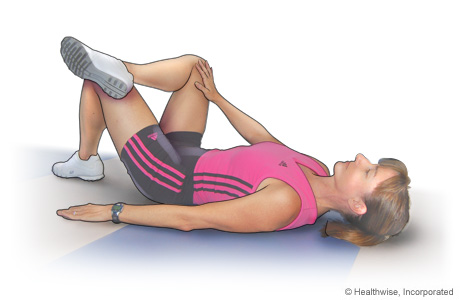
- Lie on your back with both knees bent and your feet on the floor.
- Put the ankle of the leg you are going to stretch on your opposite thigh near your knee.
- Push gently on the knee of the leg you are stretching until you feel a gentle stretch around your hip.
- Hold the stretch for at least 15 to 30 seconds. Repeat 2 to 4 times.
Iliotibial band and buttock stretch
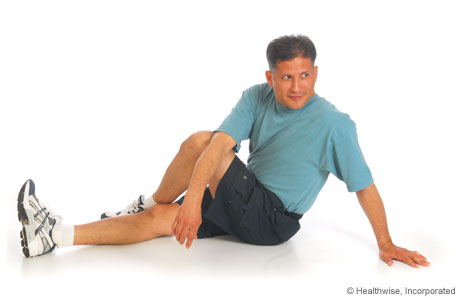
- Sit on the floor with your legs out in front of you.
- Bend the knee of the leg you want to stretch, and put that foot on the floor on the outside of the opposite leg. (Your legs will be crossed.)
- Twist your shoulders toward your bent leg, and put your opposite elbow on that knee.
- Push your arm against your knee to feel a gentle stretch at the back of your buttock and around your hip.
- Hold the stretch for at least 15 to 30 seconds. Repeat 2 to 4 times.
Calf stretch
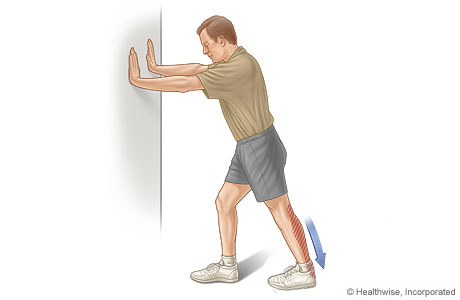
- Stand facing a wall with your hands on the wall at about eye level.
- Put the leg you want to stretch about a step behind your other leg.
- Keeping your back heel on the floor, bend your front knee until you feel a stretch in the back leg.
- Hold the stretch for at least 15 to 30 seconds. Repeat 2 to 4 times.
Related Information
Credits
Current as of: November 9, 2022
Author: Healthwise Staff
Medical Review:
William H. Blahd Jr. MD, FACEP - Emergency Medicine
Kathleen Romito MD - Family Medicine
E. Gregory Thompson MD - Internal Medicine
Adam Husney MD - Family Medicine
Patrick J. McMahon MD - Orthopedic Surgery
Current as of: November 9, 2022
Author: Healthwise Staff
Medical Review:William H. Blahd Jr. MD, FACEP - Emergency Medicine & Kathleen Romito MD - Family Medicine & E. Gregory Thompson MD - Internal Medicine & Adam Husney MD - Family Medicine & Patrick J. McMahon MD - Orthopedic Surgery

